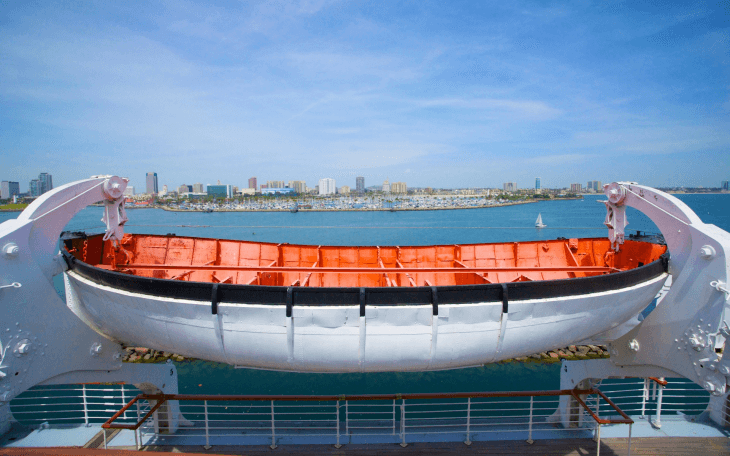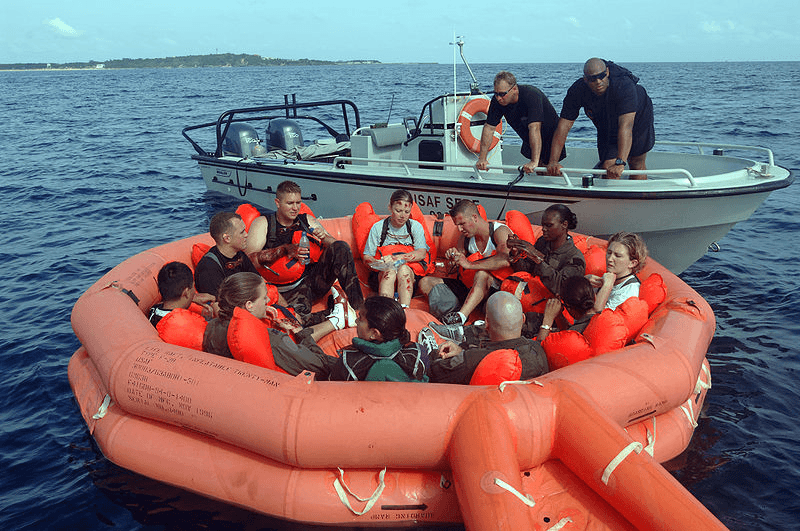Lifeboats and Life Rafts Information
 Lifeboats and life rafts are small, rigid or inflatable boats for the emergency evacuation of a vessel. They provide refuge from open water conditions to increase the survivability of passengers and crew after abandoning an unseaworthy vessel. These rescue craft sometimes have a limited quantity of supplies for passengers awaiting rescue. Certain types are also found on aircraft that have been abandoned at sea.
Lifeboats and life rafts are small, rigid or inflatable boats for the emergency evacuation of a vessel. They provide refuge from open water conditions to increase the survivability of passengers and crew after abandoning an unseaworthy vessel. These rescue craft sometimes have a limited quantity of supplies for passengers awaiting rescue. Certain types are also found on aircraft that have been abandoned at sea.
Lifeboats may have a rigid, fiberglass or wood hull or may be inflatable; generally, life rafts are strictly inflatable. Inflatable rescue craft may have auto-inflation devices such as carbon dioxide canisters or mechanical pumps, or may be inflated prior to deployment. Rigid lifeboats may be collapsible. Dinghies and tenders may have auxiliary functions as lifeboats, provided they remain with the primary vessel while underway. Lifeboats may be launched or retrieved via a hoist or slipway from the vessel. Lifeboats typical include an outboard gas or electric motor. Regular inspection of lifeboats is carried out by crew to ensure operation in an emergency. Due to their larger size and equipment requirements, lifeboats are more common on large commercial vessels.
Life rafts are packed into sturdy fiberglass containers or waterproof bags that are released overboard and deployed. They typically do not include motors. Life rafts are made of puncture-resistant neoprene or polyurethane fabric. Life rafts are often found on commercial vessels, but are also suitable for recreational vessels and airplanes as they can be packaged into a smaller footprint. Life rafts must be periodically sent to the manufacturer or certified inspection facility to ensure the life raft can be reliably deployed in an emergency.
They typically do not include motors. Life rafts are made of puncture-resistant neoprene or polyurethane fabric. Life rafts are often found on commercial vessels, but are also suitable for recreational vessels and airplanes as they can be packaged into a smaller footprint. Life rafts must be periodically sent to the manufacturer or certified inspection facility to ensure the life raft can be reliably deployed in an emergency.
Safety
Lifeboat and life raft availability on large ships and commercial vessels is subject to international, national and regional laws. Legislation typically requires that a vessel carry sufficient lifeboats and life rafts to ensure all passengers can be rescued; in certain instances this lifeboat and life raft capacity requirement is doubled, so that should the boat be listed rescue craft on the other side of the ship are still accessible. In the United States, these requirements are typically overseen by the United States Coast Guard.
It should be noted that passengers and crew should 'step up' into lifeboats and life rafts--one should remain on the primary vessel until its sinking or capsizing is imminent. It is best to stay with the primary vessel as long as possible, even if it is considerably impaired, as chances of rescue are higher on a larger, better-equipped ship.
Video credit: Seafood Training Tasmania
Types of Lifeboats and Life Rafts
- Rescue platforms are flat disks that keep stranded mariners and passengers out of the water to increase survival time by reducing potential for hypothermia. Rescue platforms lack survival gear, and generally lack a ballast system. They are typically found on aircraft.
- Coastal or near-shore life rafts generally have a single inflatable tube around the raft perimeter, a manual or self-erecting canopy, a ballast system, and raft survival essentials. Capacities vary from two to six people.
- Offshore or ocean rafts have either a single inflatable tube or two stacked tubes, and a large self-erecting canopy. These rafts have more gear in the equipment pack than the coastal rafts. Capacities vary from four to 12 people.
- An open lifeboat is the least common type of lifeboat. This type is commonly found only on older ships. These boats have no roof, are usually rowed by hand with oars, have no self-draining mechanism, and have few safety features.
- A closed lifeboat is the most commonly used type of lifeboat on ships. These are enclosed, with a door to prevent water entry; the closed shape ensures safety of passengers. Closed lifeboats are motorized.
- Free fall lifeboats differ in shape from closed lifeboats. These boats are mounted on a slipway, typically above the level of the main deck. They are for vessels, such as container ships, that might sink quickly due to heavy payloads. Such lifeboats are released and splashdown with considerable force; they are reinforced to withstand this impact.
Specifications and Features
- Capacity: the number of passengers the boat or raft can sustain
- Size: the weight and pre-deployment dimensions of a lifeboat or raft; important for configuration storage on a vessel
- Provisions: emergency food and water supplies; often liasted as less than 24 hours or more than 24 hours
- Ballast: pockets under the raft fill with water to reduce the potential of it capsizing
- Bailer: a means to remove water from the bottom of the boat or raft
- Righting line: a rope or strap that individuals can utilize to right the raft or boat, should it capsize
- Repair kit: include leak stoppers and rubber adhesives to repair punctures in inflatable rafts and boats
- Self rescue: includes equipment that passengers can use to instigate a rescue. Includes propulsion mechanisms (motor, oars or a sail); visual signals such as flashlights, chemical light sticks, heliographs, strobe lights, reflective tape, and signal flares; and radio equipment.
- Sea anchors: a high drag mechanism sheeted under the raft or boat to reduce drift, prevent spinning, and steady the craft in wind
- Canopy: an overhead fabric that protects passengers from weather and waves
- Hand pump or bellows: a means to inflate the boat as air pressure is lost, either by puncture or decreasing ambient temperatures.
- Other: equipment includes sea sickness tablets, sponges, and fishing line with hooks, among others.
Resources
Blue Water Sailing—A Guide to Life rafts, Their Equipment, Storage and Deployment



